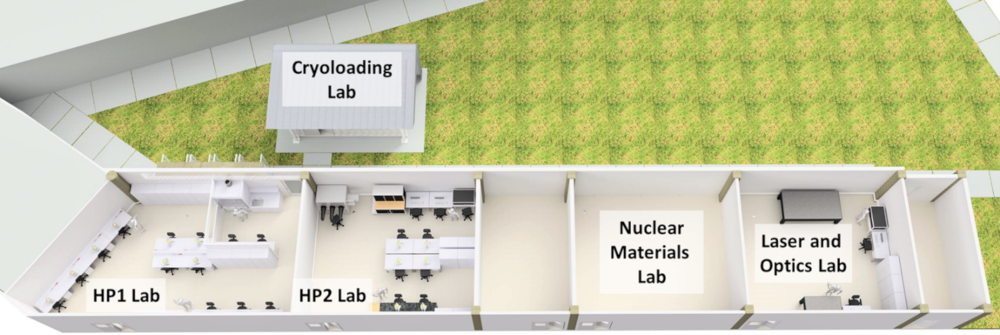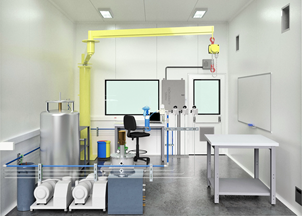CONTACT & STAFF
Facility Tel.: +55 19 3512 3570
Coordination: Danusa do Carmo
Tel.: +55 19 3518 3524
E-mail: danusa.carmo@lnls.br
Click here for more information on this Facility team.
The Extreme Thermodynamic Conditions Laboratory (LCTE) is dedicated to the development of scientific instrumentation and for supporting of experiments on Sirius beamlines, in which the sample environment mainly involves high pressure, magnetic field, and variations of temperature. LCTE’s infrastructure is divided into five sectors, where each laboratory is dedicated to a different sample condition. This set of laboratories is located on axis 44, along to the EMA beamline.

Overview of the laboratories that make up the LCTE.
Facility Tel.: +55 19 3512 3570
Coordination: Danusa do Carmo
Tel.: +55 19 3518 3524
E-mail: danusa.carmo@lnls.br
Click here for more information on this Facility team.
The application of pressures in the MBar regime is done using diamond anvil cells, the DACs. The high-pressure laboratories (HP1 and HP2 Lab) provide the necessary conditions to prepare the pressure cells and for loading samples into these devices, which will be analyzed in experiments on the beamlines. To make this preparation, the high-pressure laboratories have:
Scientific instrumentation developments are also carried out in these two laboratories, for allowing experiments outside the standard conditions (high pressure, applied magnetic field and cryogenic temperatures). These instruments involve the fabrication of pressure cells and new diamond shapes for pressure application, construction of coils to apply magnetic fields, and development of custom cryostats to operate at beamlines in different temperature regimes.
Experiments with materials containing nuclear elements require special attention due to the toxicities of these materials. In order to allow a safe handling and to reconcile the use of radionuclides in the beamline experiments, a nuclear materials laboratory is being planned. This laboratory will work at a controlled pressure and will require an isolated ventilation system, and its access will be done through antechambers equipped with radiation contaminant detectors. This laboratory will have:
This laboratory will work together with the RAD group, which will take care of the arrival of the samples into the laboratory, the storage, handling, the experiments on the beamline and the discard or returning of the sample to the user.
The optic and laser laboratory is dedicated to the development of visible optics instruments to be used simultaneously with the experiments in the beamlines, or for preliminary sample characterizations before the x-rays experiments. In this lab we will have an experimental arrangement combining a Raman spectrometer and a controlled heating system for experiments at high temperatures (up to 5000 K). In the future, we intend to acquire a high-power laser system (20 J) for the generation of shock waves, which can reach up to 1000 GPa and 80000 K.
The interaction between hydrogen and metallic elements mediated by pressure has been one of the recent interesting in the scientific community. The compression and synthesis of these metal hydrides is done using diamond anvil cells. To allow studies of hydrogen-dense metal hydrides at Sirius, we are building a cryogenic loading system to charge hydrogen (H2) into the pressure cells. This cryoloading station will have:
For security, the cryogenic loading system will be in a separated laboratory outside the Sirius building. This equipment development is being supported by the Serrapilheira Institute (FUNARBE 1709-17301).

High pressure hydrogen charging station.